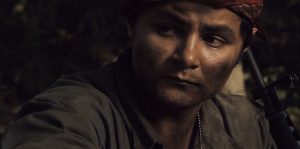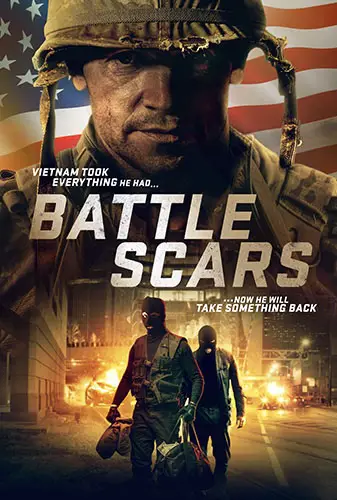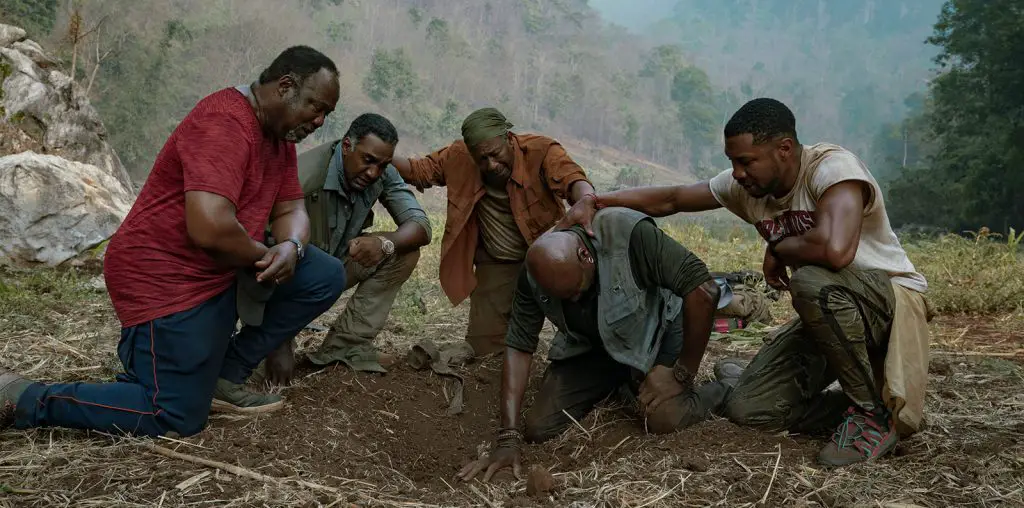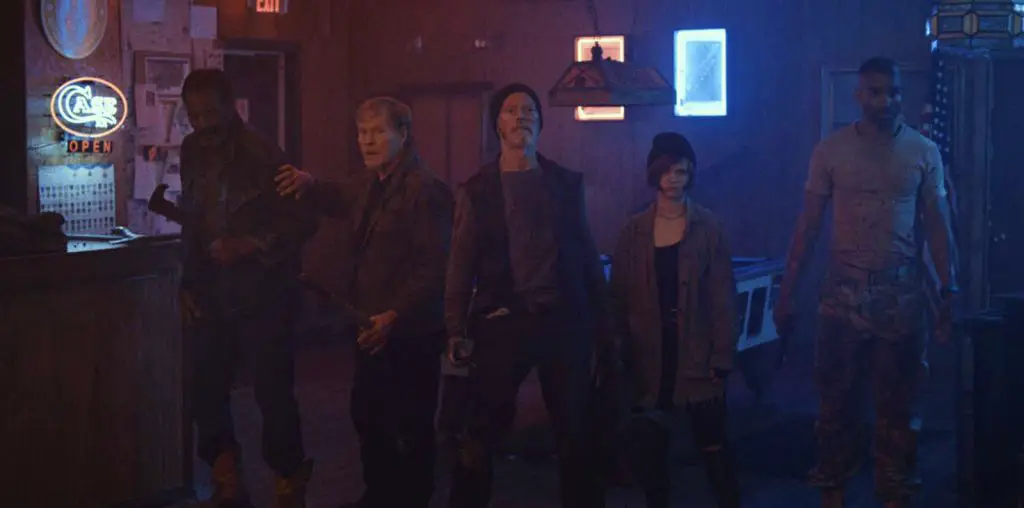
So, the plot specifics of Battle Scars are hard to invest in and make little sense. And that is a huge hurdle to get over, but there is something about Michael’s downward trajectory that compels the viewer to stick with it. It could be the non-linear telling of the narrative that keeps the audience from guessing what happens. Again, aside from those first few minutes, the film does not go a direct A to B route. After a horrific battle, Michael is back on home soil, attempting to live life like normal. His hours at work are cut, though he keeps running into Jane. Then the film flashes back to his discharge from the military, discovering that his wife died in childbirth, and meeting his son. Never knowing quite where the movie will take the audience from one scene to the next offers something to grasp onto, even when the plot fails to extend that olive branch as well as it should.
Perhaps it’s Lang’s intense performance. While his chemistry with Trosclair is nonexistent, the thespian expertly sells his character’s addiction, anger, and depression. When sitting on the floor, preparing to (possibly) commit suicide, Lang’s body language and facial expression are heartbreaking. When he asks, “where are you going,” during that motel scene, Lang portrays hatred of who he’s become brilliantly.
Maybe the thing that entices audiences to stay is Gonzalez Jr.’s stylish flair behind the camera. While the movie’s low-budget is most evident in its inauthentic period dressing and special effects, the director makes the most of what he has at his disposal. The lighting and editing perfectly place the audience into the shattered mindset of the protagonist in a very visually stimulating and exciting way. As Lang’s voice-over describes how he cannot forget the lives lost and the horrors he saw, the camera pans over from Michael on the floor and then dollies towards the window. Embers from fires begin to spark on-screen, then a flaming apparition of a killed soldier, along with other ghostly brave fighters lost, start to walk through the apartment. It is a masterful sequence.
“…the sound design mixes in the explosions and gunfire from the war into Michael’s civilian life…”
Gonzalez Jr. peppers the film with such powerful and impressive visuals. In one, admittedly unnecessary scene, Michael talks of knowing that he needs help and winds up alone in a Veteran’s Association Lodge (this could be more daydream than reality). Here, the editing discombobulates the viewer, so they never orient themselves to this new locale. It again, perfectly matches how Michael is currently seeing the world through his increasingly more broken mind.
Such fantastic style is given an enormous boost by Mike O’Heney’s elaborate and incredible sound design. Throughout the film, the sound design mixes in the explosions and gunfire from the war into Michael’s civilian life after returning home. It is a remarkable way of highlighting that the horrors of war stay with a veteran, long after the battles are over. The visuals and the sound design are impeccable and serve the themes of Battle Scars perfectly.
While flawed, Battle Scars is one of the better, more honest, and intense explorations of PTSD I have seen. The trauma is not a gimmick or being exploited in any way, as it is what drives the actions of the lead character. That alone makes the movie worth watching. It needs to rework the opening, as it is not very engaging and is at odds, style-wise, with the rest of the film. Aside from Kit Lang in the lead role, the acting is not very, and it really should have ended sooner than it does. But, somehow, Gonzalez Jr. helmed a film that is hard to look away from. Although its limitations show in places (fire is tough to get right even on a massive budget), the visual style perfectly matches the themes of the film. Add to that the truly outstanding sound design that directly places the viewer inside the mind of the PTSD-suffering lead.

"…one of the better, more honest, and intense explorations of PTSD I have seen."



This movie is a disgrace to the military and all that have severed!! It’s complete s**t!! If they guy or the personnel ever severed in any military they would know that it’s does not even begin to have any significant weight on what va we did, how we felt or how life’s as been to us after the military. Our struggles are not to be displayed as a show case of mental instability. We remember the past and our brothers and it’s hard to live with. PTSD (Put That S**t Down) and keep living your life the best way you can!!
Dear Mr. Eric Hernandez,
I appreciate your voice and agree that our issues are not to be exploited. Although in this particular film and as a fellow vet, I vehemently disagree with you. I think this movie tells a story with honor and grace only being able to be done so by a fellow vet, as is the case here, as the director is a combat veteran.
That being said, I have to ask you, because I have noticed that there are two films called Battle Scars that deal with Vets and PTSD. Did you watch this one that was set in the Vietnam War? Or, and I understand it is easy to mix up the two, did you watch the other Battle Scars set during the Afghanistan war?
Best,
-Rich